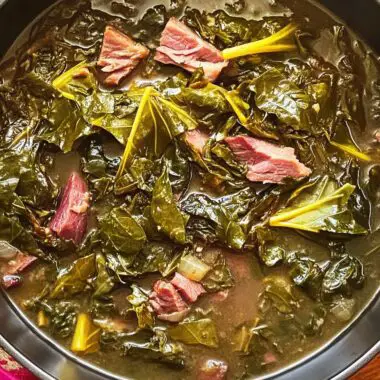The Slow Cooked Pork Stew is the epitome of comfort food. Using simple ingredients like pork shoulder, root vegetables, and savory herbs, this stew simmers all day in a slow cooker to create a dish bursting with flavor. It’s rich, satisfying, and perfect for feeding a hungry family or meal prepping for the week. This is one of those recipes that gets even better the next day. The pork becomes incredibly tender, and the vegetables soak in the delicious tomato-based broth, making each bite full of warmth. Whether served with a hunk of crusty bread or spooned over rice, this dish is a guaranteed cozy classic.
Full Recipe:
Ingredients:
-
2 pounds boneless pork shoulder, cut into 1-inch cubes
-
2 tablespoons canola oil
-
4 medium potatoes, peeled and cubed
-
4 medium carrots, sliced
-
2 medium onions, chopped
-
1 celery rib, chopped
-
1 can (14-1/2 ounces) diced tomatoes, undrained
-
1 can (8 ounces) tomato sauce
-
1/2 cup water
-
1 tablespoon Worcestershire sauce
-
1 teaspoon salt
-
1/4 teaspoon pepper
-
1/4 teaspoon dried thyme
-
1/4 teaspoon rubbed sage
-
2 tablespoons cornstarch
-
2 tablespoons cold water
Directions:
-
In a large skillet, heat canola oil over medium heat. Brown pork in batches, turning to cook evenly. Transfer to a 5-quart slow cooker.
-
Add potatoes, carrots, onions, and celery on top of pork.
-
In a separate bowl, combine diced tomatoes, tomato sauce, 1/2 cup water, Worcestershire sauce, salt, pepper, thyme, and sage. Pour mixture over the pork and vegetables.
-
Cover and cook on low for 8-10 hours or until meat and vegetables are tender.
-
In a small bowl, mix cornstarch and cold water until smooth. Stir into stew. Cover and cook on high for 30 minutes or until thickened.
Prep Time: 20 minutes | Cooking Time: 9 hours | Total Time: 9 hours 20 minutes
Kcal: 380 kcal | Servings: 6 servings
Slow Cooked Pork Stew: The Ultimate Comfort Food Classic
When the weather turns crisp and the days grow shorter, there’s something deeply comforting about a hearty stew simmering away in the kitchen. Slow Cooked Pork Stew is a time-honored dish that brings warmth to both body and soul. With tender chunks of pork, earthy root vegetables, and a savory tomato-based broth, this stew is not only rich in flavor but also packed with nutrition. In this article, we’ll explore the origins of pork stew, why slow cooking is ideal for this recipe, health benefits, serving suggestions, and tips for customizing your stew to perfection.
The History and Heart of Pork Stew
Stew as a culinary method dates back centuries, with nearly every culture around the globe having its own version. From the Hungarian goulash to French cassoulet and the Irish stew, these dishes have a common thread: humble ingredients slowly cooked to draw out deep, layered flavors. Pork stew, in particular, has long been a staple in rustic, countryside kitchens.
This Slow Cooked Pork Stew pays homage to those traditions. It’s made with pork shoulder a cut prized for its marbling and flavor. When cooked low and slow, it becomes fork-tender, melting into the savory broth. Root vegetables like potatoes and carrots add both nutrition and texture, while aromatic herbs such as thyme and sage infuse the stew with warmth and depth.
Why Slow Cooking Is the Best Method
One of the key reasons this dish is so flavorful lies in the cooking method. Slow cookers are perfect for tough cuts of meat like pork shoulder, which benefit from long, gentle cooking. This method allows the collagen in the meat to break down into gelatin, resulting in a tender and juicy texture.
But it’s not just about the meat. Slow cooking also gives the vegetables ample time to absorb the surrounding flavors. The tomatoes, Worcestershire sauce, and herbs meld together to form a deeply savory broth that envelops every bite. It’s the kind of meal that tastes like it took all day to make because it did, and it was worth every minute.
For busy home cooks, the slow cooker also offers convenience. Prep everything in the morning, set it, and forget it. By dinnertime, your home is filled with the tantalizing aroma of a stew that’s been lovingly bubbling away for hours.
Nutritional Benefits of a One-Pot Meal
Besides being satisfying and flavorful, Slow Cooked Pork Stew is surprisingly nutritious. Pork shoulder, when trimmed properly, provides a good source of protein, essential amino acids, B vitamins (particularly B12 and B6), zinc, and selenium. These nutrients support muscle health, energy production, and immune function.
The vegetables in this stew potatoes, carrots, onions, and celery offer a spectrum of vitamins and minerals. Potatoes provide potassium and fiber, carrots are rich in beta-carotene (a precursor to vitamin A), and onions bring antioxidants like quercetin to the table. When slow-cooked, the nutrients in these ingredients are gently preserved, and the flavors are intensified.
Since this dish is cooked in a single pot with no added cream or butter, it can be considered relatively low in fat while being rich in flavor. It’s a balanced dish that’s hearty without being heavy, especially if portioned properly and paired with a light side.
Perfect Pairings and Serving Ideas
The beauty of this stew lies in its versatility. It’s perfect served as is, but there are many ways to enhance the meal or adapt it for different dining settings:
-
With Crusty Bread: Serve with thick slices of sourdough, French baguette, or even garlic bread. The broth is so flavorful you’ll want something to mop it up with.
-
Over Mashed Potatoes: For an extra layer of comfort, serve the stew ladled over a creamy bed of mashed potatoes.
-
With Rice or Egg Noodles: These absorb the flavorful sauce well and can stretch the stew into more servings.
-
As a Filling: Thicken the stew slightly and use it to fill savory pies or turnovers for a creative twist.
Garnish with fresh parsley or a sprinkle of grated Parmesan cheese for added brightness and umami.
Customizing Your Pork Stew
One of the best things about this stew is how customizable it is. Depending on what you have on hand or your flavor preferences you can tweak it to make it your own.
Swap the Veggies:
Don’t have carrots or potatoes? Try parsnips, sweet potatoes, or even rutabaga. Bell peppers or green beans can add color and freshness.
Make It Spicier:
Add a touch of chili powder, cayenne, or smoked paprika for a bit of heat and complexity. A splash of red wine or a spoonful of Dijon mustard can also elevate the flavor.
Boost the Umami:
A tablespoon of soy sauce or anchovy paste can deepen the stew’s savory character. Mushrooms especially cremini or shiitake are another great addition.
Herb Variations:
Thyme and sage are classic, but you could also experiment with rosemary, marjoram, or even a bay leaf or two. Just be cautious too many herbs can overpower the pork.
Thickening Alternatives:
If cornstarch isn’t your thing, try using flour, a bit of mashed potato, or even blending a portion of the vegetables for a naturally thickened broth.
Storing and Reheating: Better the Next Day
Like most stews, this dish improves with time. The flavors continue to develop as it rests, making leftovers highly desirable.
To store:
Allow the stew to cool to room temperature before transferring it into airtight containers. It will keep in the refrigerator for up to 4 days.
To freeze:
Pork stew freezes beautifully. Portion into freezer-safe containers, leaving a little room for expansion. Label and date it it’s good for about 3 months.
To reheat:
Thaw overnight in the fridge if frozen. Reheat gently on the stove or in the microwave, adding a splash of broth or water if needed to loosen the consistency.
A Great Dish for Any Occasion
While pork stew might feel like a winter comfort food, its simplicity and depth of flavor make it suitable for all seasons. It’s ideal for:
-
Family dinners when you want something hearty but low-effort.
-
Entertaining guests, especially in colder months this stew feels like a warm hug.
-
Meal prepping for busy weeks it’s filling, nutritious, and reheats like a dream.
-
Potlucks or gatherings, where a slow cooker full of goodness is always appreciated.
Whether you’re cooking for yourself or a crowd, this stew brings people together with every savory spoonful.
Conclusion:
Slow Cooked Pork Stew is more than just a recipe it’s a tradition. It’s about slowing down, using humble ingredients, and transforming them into something memorable and comforting. With tender pork, hearty vegetables, and a broth rich in tomato and herb goodness, this dish is a masterclass in simplicity done well.
It invites creativity, adapts to what you have on hand, and rewards patience with rich, developed flavor. Whether you’re new to cooking or a seasoned home chef, this stew is a reliable, soul-satisfying favorite that deserves a permanent place in your recipe collection.








